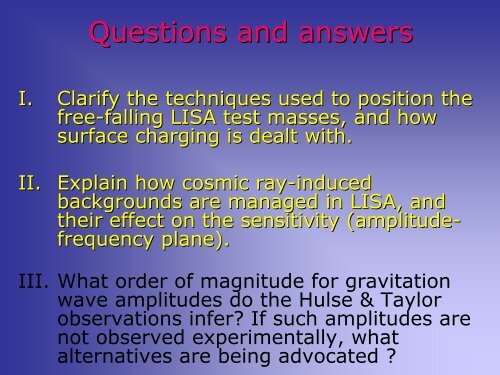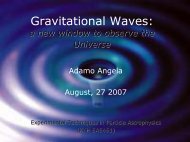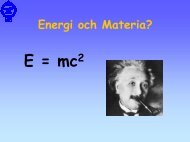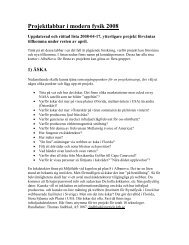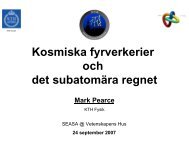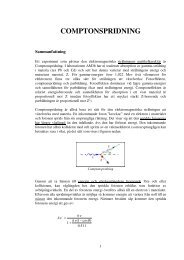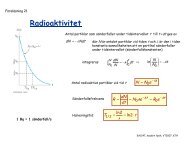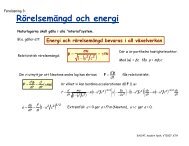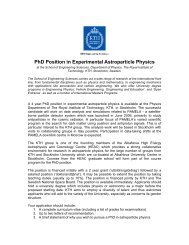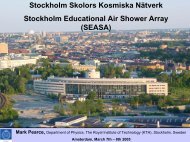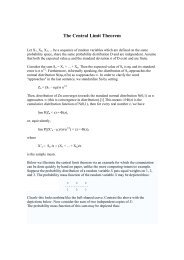Gravitational Waves: a new window to observe the Universe
Gravitational Waves: a new window to observe the Universe
Gravitational Waves: a new window to observe the Universe
You also want an ePaper? Increase the reach of your titles
YUMPU automatically turns print PDFs into web optimized ePapers that Google loves.
Questions and answers<br />
I. Clarify <strong>the</strong> techniques used <strong>to</strong> position <strong>the</strong><br />
free-falling falling LISA test masses, and how<br />
surface charging is dealt with.<br />
II.<br />
Explain how cosmic ray-induced<br />
backgrounds are managed in LISA, and<br />
<strong>the</strong>ir effect on <strong>the</strong> sensitivity (amplitude-<br />
frequency plane).<br />
III. What order of magnitude for gravitation<br />
wave amplitudes do <strong>the</strong> Hulse & Taylor<br />
observations infer? If such amplitudes are<br />
not <strong>observe</strong>d experimentally, what<br />
alternatives are being advocated ?
• proof masses have a double role:<br />
1 - mirrors for <strong>the</strong> interferometer<br />
2 - inertial references for <strong>the</strong> drag-free<br />
control system.<br />
• The drag-free control system consists of:<br />
1 - inertial sensor<br />
2 - proportional micro-propulsion system<br />
3 - control loop
• The displacement of <strong>the</strong> cubes with respect <strong>to</strong> <strong>the</strong>ir<br />
housing is measured by capacitive sensing in three<br />
dimensions.<br />
• These position signals are used in a feedback loop<br />
<strong>to</strong> command proportional micro-propulsion<br />
thrusters <strong>to</strong> enable <strong>the</strong> spacecraft <strong>to</strong> remain<br />
centered on <strong>the</strong> proof mass.<br />
• Field Emission Electric Propulsion<br />
(FEEP) thrusters<br />
will be used<br />
as actua<strong>to</strong>rs.
• cosmic rays and solar flare particles can<br />
significantly charge <strong>the</strong> proof mass surfaces<br />
(see “Cosmic-ray spectra near <strong>the</strong> LISA orbit”,<br />
Grimani et al. 2004 Class. Quantum Grav., 21<br />
S629)<br />
• A system of fiber-coupled UV lamps will discharge<br />
<strong>the</strong> proof masses at regular intervals<br />
• In order not <strong>to</strong> damage <strong>the</strong> coating during<br />
launch, a caging mechanism is used <strong>to</strong> maintain<br />
<strong>the</strong> proof masses in a safe position during launch.
Questions and answers<br />
I. Clarify <strong>the</strong> techniques used <strong>to</strong> position <strong>the</strong><br />
free-falling LISA test masses, and how<br />
surface charging is dealt with.<br />
II.<br />
Explain how cosmic ray-induced<br />
backgrounds are managed in LISA, and<br />
<strong>the</strong>ir effect on <strong>the</strong> sensitivity (amplitudefrequency<br />
plane).<br />
III. What order of magnitude for gravitation<br />
wave amplitudes do <strong>the</strong> Hulse & Taylor<br />
observations infer? If such amplitudes are<br />
not <strong>observe</strong>d experimentally, what<br />
alternatives are being advocated ?
What order of magnitude for gravitation wave<br />
amplitudes do <strong>the</strong> Hulse + Taylor<br />
observations infer?<br />
PSR B1913+16<br />
d = 6.44 pc --> about 0.1 – 1 Hz<br />
h ~ 10 -18 –10 -20
The gravitational waves are described by:<br />
Frequency, ν<br />
Type Range Run Time Sources Instrument<br />
HF<br />
10 Hz →<br />
1000 Hz<br />
one per day<br />
Compact<br />
stars<br />
bars, LIGO,<br />
VIRGO<br />
MF<br />
0.1 Hz →<br />
10Hz<br />
one per<br />
a few days<br />
NS binary<br />
inspiral<br />
Advanced<br />
LIGO<br />
LF<br />
10 μHz →<br />
10 mHz<br />
one per year<br />
binaries<br />
SMBHs<br />
LISA<br />
VLF<br />
1 nHz →<br />
10 μHz<br />
once in a<br />
lifetime<br />
cosmic<br />
astrophysics<br />
PTA<br />
ULF<br />
10 nHz →<br />
0 Hz<br />
snapshots<br />
only<br />
cosmic<br />
structure<br />
COBE, MAP<br />
Planck, etc.
If such amplitudes are not <strong>observe</strong>d<br />
experimentally, what alternatives are being<br />
advocated ?<br />
From <strong>the</strong> Occam’s razor:<br />
“entia non sunt multiplicanda praeter necessitatem”<br />
(entities should not be multiplied beyond necessity)<br />
Actually, any <strong>new</strong> alternative has been<br />
formulated <strong>to</strong> explain <strong>the</strong> orbital period decay<br />
of <strong>the</strong> Hulse & Taylor pulsar!


